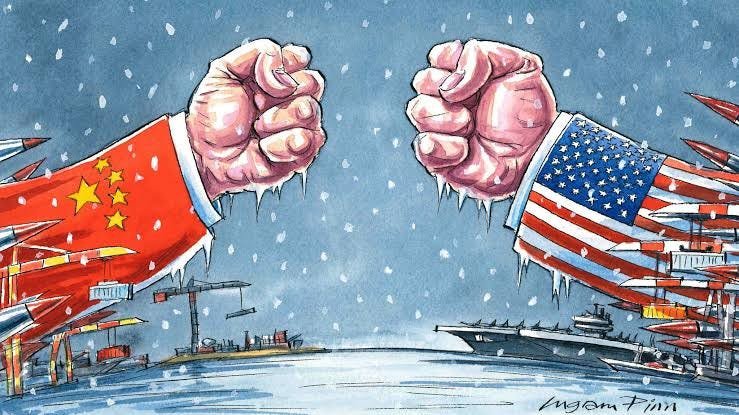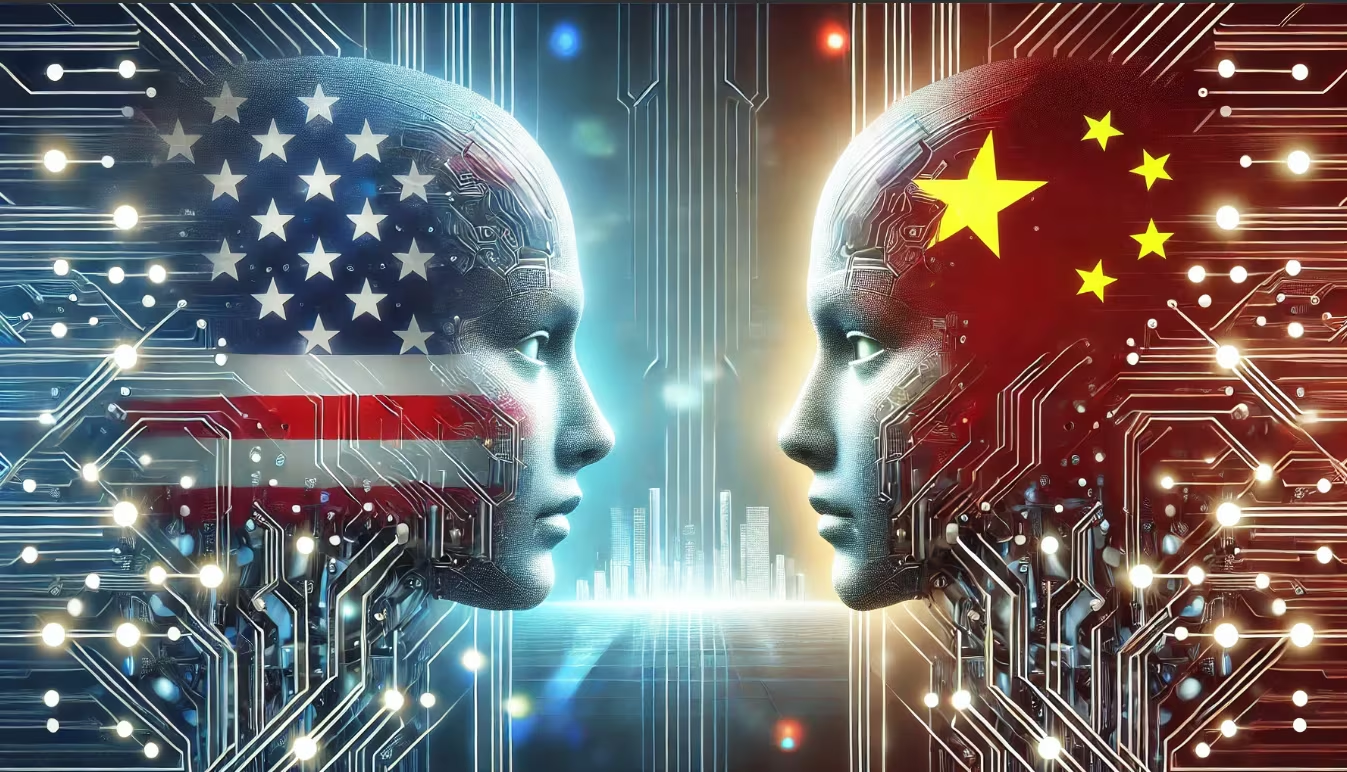
The global tech industry is evolving rapidly, driven by the acceleration of artificial intelligence (AI). The competition is intensifying as the U.S. tech giants, traditionally dominant in the AI sector, face increasing pressure from Chinese competitors and internal challenges. The combination of shifting market dynamics, geopolitics, and trade policies, particularly surrounding semiconductors and AI technologies, is reshaping the landscape. This article explores the growing AI boom, competition from China, and the U.S. tech sector’s strategic responses.
The Changing Tech Landscape: AI Driving Transformation
The AI-driven Tech Selloff
The first quarter of 2025 has been marked by notable shifts in sentiment within the tech sector, especially for companies tied to the AI boom. The likes of NVIDIA, Broadcom, and Amazon, which have enjoyed massive growth due to the surge in AI demand, are now facing significant drops in their stock prices. Despite impressive revenue growth driven by AI products, these companies are struggling to meet market expectations, resulting in earnings misses that have sent stocks into a decline.
For example, NVIDIA, a leader in AI chips, saw a 2.4% drop, despite an otherwise optimistic outlook for AI adoption. The issue lies in the incredibly high valuations attached to these companies, which now seem unsustainable when earnings growth fails to meet investor expectations.
Why the Decline?
- High Valuations: After the pandemic-driven surge in stock prices, the current market reality is that these companies’ AI-driven valuations are outpacing their earnings, leading to investor skepticism.
- Earnings Disappointments: Companies such as Broadcom and Amazon, despite impressive growth, fell short of analyst expectations in their earnings reports.
- Market Caution: As the global economic environment grows increasingly uncertain due to inflation, interest rate concerns, and supply chain issues, investor confidence in the tech sector is wavering.
These challenges represent a temporary slowdown for U.S. tech companies, but the real threat to their dominance is coming from international competition, particularly from China.
The Growing Threat from Chinese AI Competitors
Chinese tech giants like Alibaba and Tencent are rapidly advancing in the AI space, offering competitive solutions that challenge the U.S.’s technological edge. For instance, Alibaba recently unveiled an AI model that boasts superior performance with far fewer data and computational resources than the U.S. counterparts, demonstrating China’s growing capabilities.
Why China is Gaining Ground
- Cost Efficiency: Chinese companies can develop AI models at a much lower cost, making their AI solutions more accessible and scalable.
- Government Support: The Chinese government has long invested heavily in AI development, ensuring that Chinese companies like Alibaba and Tencent have the resources to compete on a global scale.
- Faster Innovation: Chinese companies have proven adept at quickly adapting and scaling their AI offerings, reducing the dependency on expensive hardware infrastructure.
This trend is evident in the Hang Seng Tech Index, which has surged by 5%, adding $153 billion in market value to Alibaba alone since January 2025. The aggressive rise of Chinese tech companies in AI signals that the U.S. may soon face stiffer competition than ever before.
Geopolitical Tensions and U.S.-China Trade Relations
The U.S.-China trade war has added complexity to the global tech race, with ongoing tariffs, export controls, and sanctions affecting the flow of tech products and expertise. The Biden administration, building on former President Trump’s policies, continues to implement tariffs on Chinese imports, particularly in the tech sector, while also imposing export controls on key technologies like AI and semiconductor components.

Key Issues to Watch in U.S.-China Tech Trade Relations:
- Tariffs: A 20% tariff on Chinese tech imports has created a more challenging environment for U.S. companies that rely on Chinese manufacturing.
- Export Controls: The U.S. has placed restrictions on certain AI technologies, hindering Chinese companies from accessing advanced U.S. technologies and services.
- Impact on Collaboration: These tensions hinder potential collaborations between U.S. and Chinese firms, making it harder for companies to innovate together in an increasingly globalized tech environment.
These ongoing geopolitical tensions are likely to continue shaping the tech industry and could have far-reaching effects on AI development, particularly in semiconductor production, which is at the core of AI technology.
The U.S. Domestic Policy Landscape
The CHIPS Act and U.S. Semiconductor Manufacturing
The U.S. government has recognized the importance of semiconductor manufacturing as a strategic national interest and passed the CHIPS Act to incentivize domestic production of semiconductors. However, political tensions and calls to repeal parts of the CHIPS Act are raising concerns about the future of U.S.-based semiconductor companies.
Potential Risks of Repealing the CHIPS Act:
- Loss of Funding: The CHIPS Act allocated billions to companies like Intel and TSMC for the development of semiconductor manufacturing within the U.S. Repealing this could result in a decrease in U.S. production capabilities, making it harder to compete with China’s fast-growing semiconductor industry.
- Supply Chain Impact: If funding dries up, it could result in further disruptions in the already fragile global semiconductor supply chain, which has faced significant shortages in recent years.
As the U.S. considers its domestic manufacturing policies, the global semiconductor race continues to heat up, with China building out its own capacity at an alarming rate.
China’s Role in the Global AI Race
China’s increasing investment in AI, supported by the state’s strategic initiatives, has given rise to significant tech developments. The country has become one of the leaders in AI and machine learning, with companies like Baidu, Alibaba, and Tencent pushing the boundaries of what’s possible in AI models.
What Makes China’s AI Strategy Different?
- Government-Driven Initiatives: The Chinese government has provided strong support for AI initiatives through state-backed research, funding, and policies.
- Leveraging Big Data: China’s population offers a unique advantage in terms of the vast amount of data available to train AI models, giving companies an edge in developing more sophisticated algorithms.
U.S. Tech’s Response to Chinese Competition
While U.S. tech companies have faced significant challenges due to competition from Chinese firms, they are not standing idly by. Amazon, Microsoft, and Google have been investing heavily in AI, making acquisitions and pouring resources into research and development to remain competitive.
U.S. companies are focusing on software innovation rather than just hardware. By offering AI as a service (AIaaS) through cloud platforms, they are able to deliver AI-powered solutions to businesses and developers, making AI more accessible without requiring expensive hardware investments.
Strategies for U.S. Tech Companies to Stay Competitive
1. Prioritize AI Efficiency and Cost Reduction
One way U.S. companies can stay ahead is by finding ways to make AI development more efficient. This could involve leveraging less data and computing power to create models that perform similarly to those built by Chinese companies, which would help reduce costs and improve scalability.
2. Expand Diversification Efforts
U.S. tech firms need to diversify their portfolios to ensure that they aren’t overly reliant on one technology or product. With AI playing a central role in the tech space, it’s crucial for companies to focus on expanding their AI-driven products and services.
3. Form Global Partnerships
Collaboration between U.S. companies and international firms could be key to thriving in an increasingly competitive global market. By pooling resources and expertise, companies can develop cutting-edge solutions and share risk in a volatile economic climate.
The Future of U.S. Tech in the Global AI Race
The landscape of AI and semiconductor development is evolving rapidly, with the U.S. facing increasing competition from China. Despite some setbacks in stock prices and earnings, U.S. tech giants remain at the forefront of innovation. However, the growing prominence of Chinese AI companies signals a shift in the market, highlighting the need for U.S. companies to innovate faster and adapt to the changing global environment.
Conclusion: Moving Forward in an AI-Driven World
The future of the U.S. tech sector, particularly in AI, is far from certain. With competition from China on the rise and internal challenges looming, U.S. companies must focus on innovation, cost-efficiency, and global collaboration to stay competitive. While market fluctuations are inevitable, tech companies that can adapt quickly will continue to lead the charge in AI development.
Call to Action:
The world of AI is constantly evolving, and the race for dominance is only getting fiercer. To stay ahead of the curve, companies and investors must keep a close eye on global developments, particularly from China. For further insights on the state of AI and tech, stay informed and continue to engage with industry reports and expert analyses.
Sources:
